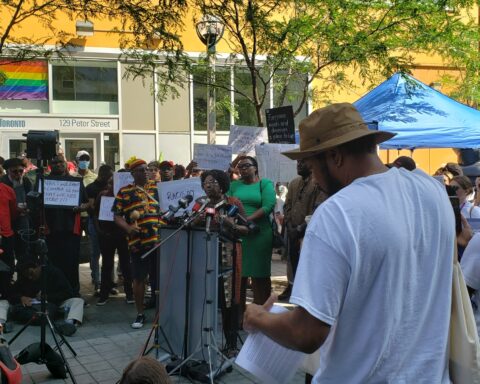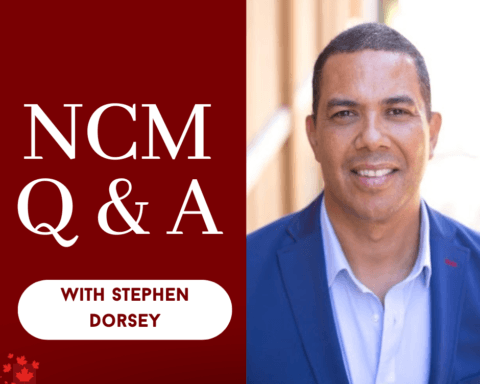The largest municipal police service in Canada has a new chief. A first for the City of Toronto, Mark Saunders is of African descent – born in England to Jamaican parents. A 32-year veteran of the Toronto Police Service (TPS), Saunders succeeds William Blair.
Saunders, of course, is not the first Black police chief in Canada. That honour went to Winnipeg’s Devon Clunis. But, for Toronto, it is still an historic achievement, as Saunders’ 10-year-old son noted.
That Toronto was in line to get its first Black police chief was not so much a big surprise.
Two of the leading contenders for the job were of African descent, Peter Sloly and Saunders. Both were two of the three deputy chiefs to retiring Chief Blair. What was most surprising, particularly to the Black community in Toronto, was that it was Saunders who got the job, not Sloly.
The expectation was that the new chief should have a complete understanding of the challenges and tensions that exist between the police and the Black community in particular. The appointment of a Black chief could be a step in the right direction.
Sloly was more known to the community, in a way that Saunders was not. Shortly before the announcement, the publisher/senior editor of Share, Arnold Auguste, wrote: “… our endorsement was based on our knowledge of Deputy Chief (DC) Sloly over many years and the expectation that he would bring, not only the right skillset, but the right attitude and sensitivity to this important job.
We couldn’t say the same for DC Saunders, because we don’t know him as well as we know Sloly. For all we know, he might make an even better chief, but we don’t know that.”
That, in many ways, summed up the general feeling of Toronto’s Black community.
The Toronto Police Services Board (TPSB), a civilian oversight body, had launched what it called a “global search”, using a recruiting agency, to find the right fit for the City of Toronto. It would have been a serious error if the new chief were someone from another part of Canada, let alone another part of the world.
The expectation was that the new chief should have a complete understanding of the challenges and tensions that exist between the police and the Black community in particular. The appointment of a Black chief could be a step in the right direction.
And herein lies one of the main challenges facing Saunders.
The Black Community and the Police
In 2002, the Toronto Star published a series of articles that highlighted the racial profiling of Blacks by the Toronto Police. The chief of police at the time, Julian Fantino, denied that the Service, with the possible exception of “a few bad apples”, practised racial profiling. When Blair took over as chief, he was more forthcoming in admitting existence of racial profiling and a pledge to stop it.
In March, 2012, the Toronto Star published “Known to Police”, articles that showed that not only was racial profiling continuing, but it had morphed to the point where individual young, Black men were being stopped, documented and entered into a database, supposedly as part of future investigations. This practice is commonly referred to as “carding”.
Chief Saunders will have very little time to get comfortable in his new chair… he has to put this carding issue to rest. That will not be easy.
Very shortly after the Star’s revelation, Chief Blair ordered an internal review of the service’s community engagement practices. This resulted in a 90-page report: Police and Committee Engagement Review (PACER). DC Sloly coordinated the review with contributions from several members of the service, including DC Saunders.
The PACER report was to form the basis of a policy that, among other things, would inform individuals of their right to “walk away” from an engagement if they were not under suspicion or being detained. That recommendation was dropped from the policy that has just been approved by the TPSB.
Hardest Challenge: Building Trust
Chief Saunders will have very little time to get comfortable in his new chair. Apart from finding ways to deal with an ever-increasing budget, assessing and dealing with the day-to-day activities of a 5,500 “uniform strength” service and adapting the organization to better suit his vision, he has to put this carding issue to rest. That will not be easy.
Fundamentally, it will be a case of trust. The police argue that engagement with residents is an essential part of “intelligence-led” policing.
“Being Black is fantastic, but it doesn’t give me superpowers.” – Mark Saunders
The community – specifically, the Black community – is very suspicious of the police, and with good reason. Several reports over the years have acknowledged harsher treatments of Black people in the criminal justice system than their White counterparts.
Saunders comes to the office with the branding of being “a cop’s cop”, a well-respected officer among his fellow officers who has held, and excelled in, several critical command posts. As chief, he would be expected to defend and advocate for the men and women in his command.
But he is Black. As such, he should have an intimate knowledge and, perhaps, experience that none of his predecessors have. The community will therefore be watching closely to see how he balances those two realities. At his introduction to the public as the chief-designate, Saunders noted: “Being Black is fantastic, but it doesn’t give me superpowers.”
Patrick Hunter is a communications consultant and a columnist for Share Newspaper. He is a former communications director at the Canadian Race Relations Foundation and has worked in government and the news media.
An experienced communications professional with very strong writing and editing skills, communications planning, media relations, stakeholder/community relations and issues management; has worked in government, and has significant expertise in anti-racism, human rights and diversity issues.





